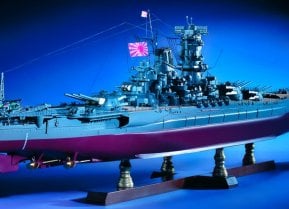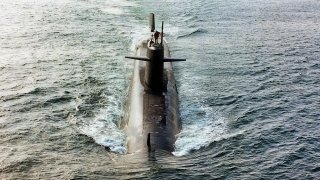The U.S. Navy's Ethan Allan-Class Missile Submarines Had Just 1 Mission
The Ethan Allen-class submarines, designed as successors to the George Washington class, were central to the U.S. Navy's "41 for Freedom" ballistic missile fleet during the 1960s.
Summary: The Ethan Allen-class submarines, designed as successors to the George Washington class, were central to the U.S. Navy's "41 for Freedom" ballistic missile fleet during the 1960s. Built to carry the Polaris A-2 missile, these submarines were a key part of America's Cold War deterrent strategy against the USSR. Commissioned in the early 1960s, the class included ships like the USS Ethan Allen, which played a significant role in testing the Polaris missile. The Ethan Allen-class represented a technological advancement with their nuclear-powered design and missile capabilities. However, the SALT II treaty later restricted their strategic role, leading to their eventual decommissioning and disposal.
Ethan Allen-Class: The Submarines That Shaped Nuclear Deterrence
Commissioned mainly in the 1960s, the U.S. Navy’s ballistic missile submarine fleet comprised the service’s “41 for Freedom.”
The George Washington, Ethan Allan, Lafayette, James Madison, and Benjamin Franklin classes were designed to create a survivable and credible sea-based deterrent as the Cold War between the U.S. and USSR was heating up.
In the 1960’s, the Navy proposed acquiring 41 nuclear-powered ballistic missile submarines. However, the 1932 SALT 1 Treaty limited this goal.
Introducing the Ethan Allan-Class: One Clear Mission
Designed as a successor to the George Washington class, the Ethan Allen SSBNs were uniquely constructed to be capable of launching ballistic missiles against the Soviet Union, Warsaw Pact or any nation or nations that threaten the United States .
The class's lead ship, Ethan Allan, was constructed by General Dynamics Electric Boat and commissioned in 1961.
Sam Houston was next to commission one year later, built by Newport News Shipbuilding and Drydock Corporation.
The fourth and fifth ships in the class, John Marshall and Thomas Jefferson, were also constructed by Newport News, while General Dynamics built the third ship Thomas A. Edison. The water-cooled Westinghouse 5SW reactor powered the Ethan Allen Class submarines.
While the first three ships in the class were equipped with turbines designed by Westinghouse, the last two submarines were installed with turbines from General Electric.
Weapons Platforms for This SSBN Class
While they were functionally similar to their predecessors, the Ethan Allen submarines could carry the Polaris A-2 missile and were longer with less torpedo tubes incorporated. USS George Washington was the first submarine to be able to successfully launch the UGM-27 Polaris submarine-launched ballistic missile in the early 1960’s.
Once launched from a moving underwater platform, the two-stage, solid-fueled, nuclear-armed weapon was essentially invulnerable to counterattack.
The A-2 variant of the Polaris entered service in 1961, sporting several upgrades from the original weapon. However, issues surrounding the weapon’s W-47 warhead ultimately led to large numbers of A-2 missiles being recalled for modifications. Over the next decade, these missiles were replaced with the upgraded A-3 Polaris variants.
When both American and Soviet negotiators penned the SALT II treaty to hinder the production of strategic nuclear weapons by both countries, new missile programs were banned.
The U.S. was able to preserve its Trident missile program, but the Ethan Allan submarines were forced to be redesignated as fast attack submarines.
To comply with the treaty’s guidelines, the missile fire control systems were removed from these submarines and their missile tubes were filled with concrete.
More Ethan Allan-Class Technical Details
Like her George Washington predecessors, Ethan Allen was built from the HY80 steel. She was equipped with the Mark 2 Mod 3 Ships Inertial Navigation System, Mark 16 Mod 6 torpedoes and the Mark 112 Mod 2 in addition to the Polaris A-2 initially.
In 1962, Ethan Allen launched a Polaris missile over the South Pacific in the Navy’s first complete operational test of a strategic missile.
Following this test, Ethan Allen returned to the East Coast to be rearmed with the Polaris and continued her first deployment cycle in 1962.
Retirement
Following nearly two decades of service, Ethan Allen was redesignated as SSN 608 but only served in her new role for three years. By 1983, she was decommissioned and was officially stricken from the Navy list. Ethan Allen remained at the Puget Sound Naval Shipyard in Bremerton Washington prior to being disposed of through the Navy’s Nuclear Powered Ship and Submarine Recycling Program in 1999.
Maya Carlin, National Security Writer with The National Interest, is an analyst with the Center for Security Policy and a former Anna Sobol Levy Fellow at IDC Herzliya in Israel. She has by-lines in many publications, including The National Interest, Jerusalem Post, and Times of Israel. You can follow her on Twitter: @MayaCarlin.


